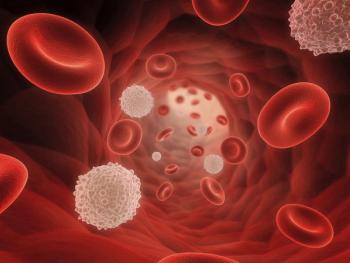
Radioligand Therapy Combo Boosts rPFS in PSMA+ Metastatic HSPC
Findings from the PSMAddition trial support the benefit of the early addition of lutetium Lu 177 vipivotide tetraxetan in metastatic HSPC.
A statistically significant improvement in radiographic progression-free survival (rPFS) occurred among patients with prostate specific-membrane antigen (PSMA)–positive metastatic hormone-sensitive prostate cancer (mHSPC) following treatment with lutetium Lu 177 vipivotide tetraxetan (Pluvicto) plus an androgen receptor pathway inhibitor (ARPI) and androgen deprivation therapy (ADT), according to data from the phase 3 PSMAddition trial (NCT04720157) presented at the
Data demonstrated that patients treated with the lutetium Lu 177 vipivotide tetraxetan combination (n = 572) achieved a median rPFS that was not reached (NR; 95% CI, not evaluable [NE]-NE) compared with NR (95% CI, 29.7-NE) patients treated with an ARPI and ADT alone (HR, 0.72; 95% CI, 0.58-0.90; P = .002).
“Taken together, [safety and quality-of-life (QOL)] findings support the clinical benefit of the early addition of lutetium Lu 177 vipivotide tetraxetan to the backbone of ADT and ARPI,” lead study author Scott T. Tagawa, MD, MS, FACP, FASCO, said in a presentation of the data. Tagawa is a professor of medicine and urology at Weill Cornell Medicine and an attending physician at NewYork-Presbyterian – Weill Cornell Medical Center.
Why Was Lutetium Lu 177 Vipivotide Tetraxetan Evaluated in the mHSPC Setting?
Lutetium Lu 177 vipivotide tetraxetan earned initial FDA approval in March 2022 for the treatment of adult patients with PSMA-positive metastatic castration-resistant prostate cancer (mCRPC) who have previously received other anticancer therapies, such as ARPI therapy and taxane-based chemotherapy.2 The radioligand therapy’s indication was expanded in March 2025 to include patients with PSMA-positive mCRPC who have been treated with ARPI therapy and are considered appropriate to delay taxane-based chemotherapy.3
Given the efficacy of the agent displayed in the mCRPC population, investigators launched the first phase 3 study designed to evaluate targeted radioligand therapy in patients with mHSPC.1
What Was the Trial Design of PSMAddition?
Enrolled patients in the randomized PSMAddition trial were required to have untreated or minimally treated mHSPC with at least 1 PSMA-positive metastatic lesion. Patients were required to have an ECOG performance status of 0 to 2 and be considered candidates for treatment with an ARPI and ADT.
Investigators randomly assigned patients 1:1 to receive lutetium Lu 177 vipivotide tetraxetan at 7.4 GBq ±10% once every 6 weeks for 6 cycles, plus investigator’s choice of ARPI and ADT; or an ARPI plus ADT alone. Notably, crossover from the control arm to experimental group was permitted after blinded independent review committee–confirmed radiographic disease progression.
Stratification factors included disease volume (high vs low), age (<70 years vs ≥70 years), and previous or planned treatment of the primary tumor with radiation or prostatectomy (yes vs no).
The study’s primary end point was rPFS per BIRC assessment and Prostate Cancer Working Group 3 and RECIST 1.1 criteria. Overall survival (OS) was a key secondary end point, with other secondary end points comprising PSA90 response rate; time to mCRPC; PFS and time to second PFS; the rates of PSA levels below 0.2 ng/mL at weeks 12, 24, and 48; BICR-assessed overall response rate, disease control rate, time to response, duration of response, and time to subsequent therapy per RECIST 1.1 criteria; safety and tolerability; health-related QOL; and time to first symptomatic skeletal event.
rPFS was previously evaluated at a first interim analysis, which was used only as a futility analysis. Data presented at the 2025 ESMO Congress included rPFS findings from the second interim analysis for the end point, along with results from the first interim OS analysis.
At data cutoff, 66.4% of patients in the experimental arm and 58.2% of patients in the control arm were ongoing treatment. Radiographic disease progression was reported in 19.6% and 26.6% of patients, respectively. In the experimental arm, 85.6% of patients received all 6 cycles of lutetium Lu 177 vipivotide tetraxetan, and 93.1% completed at least 4 cycles. In the control arm, 15.9% of the overall population crossed over to receive lutetium Lu 177 vipivotide tetraxetan after radiographic disease progression, which represented 59.9% of patients in the arm who had progression.
Tagawa noted that baseline characteristics were balanced between the 2 groups. Patients in the lutetium Lu 177 vipivotide tetraxetan arm had a median age of 66.0 years (range, 38-91) compared with 68.0 years (range, 36-90) in the ARPI plus ADT arm. Forty-three percent of patients in each arm were at least 70 years of age. The majority of patients in both groups had an ECOG performance status of 0 (experimental arm, 69.4%; control arm, 71.2%), a Gleason score of 8 to 10 (68.0%; 71.0%), and high tumor volume (68.0%; 68.2%). Sites of disease included soft tissue (59.8%; 59.1%), bone (91.3%; 91.1%), and visceral (39.3%; 41.6%). Patients in the lutetium Lu 177 vipivotide tetraxetan had a median PSA level of 12.06 ng/mL (interquartile range [IQR], 3.16-53.24) vs 11.64 ng/mL (IQR, 2.83-44.15) in the control arm.
In the lutetium Lu 177 vipivotide tetraxetan group, 52.1% of patients had de novo mHSPC compared with 47.9% of patients in the ARPI plus ADT arm.
What Were Findings for Secondary End Points in PSMAddition?
In the first interim OS analysis, the median OS was NR (95% CI, NE-NE) in both arms (HR, 0.84; 95% CI, 0.83-1.13; P = .125).
The ORR was 85.3% (95% CI, 79.9%-89.6%) in the lutetium Lu 177 vipivotide tetraxetan group vs 80.8% (95% CI, 74.8%-85.8%) in the control arm; the respective complete response rates were 57.1% and 42.3%.
The median time to PSA progression was NR (95% CI, NE-NE) in both groups (HR, 0.42; 95% CI, 0.30-0.59). At 48 weeks, 87.4% (95% CI, 83.6%-90.8%) and 74.9% (95% CI, 70.3-79.1%) of patients had a PSA nadir of less than 0.2 ng/mL in the experimental and control arms, respectively.
The median TTSSE was NR (95% CI, NE-NE) in both arms (HR, 0.89; 95% CI, 0.62-1.26), as was the median time to mCRPC (HR, 0.70; 9%% CI, 0.58-0.84). The median investigator-assessed PFS was NR (95% CI, NE-NE) in the lutetium Lu 177 vipivotide tetraxetan group vs NR (95% CI, 29.63-NE) in the control arm (HR, 0.64; 95% CI, 0.51-0.79).
What Was the Safety Profile of Lutetium Lu 177 Vipivotide Tetraxetan?
Regarding safety, any-grade adverse effects (AEs) occurred in 98.4% of patients in the lutetium Lu 177 vipivotide tetraxetan plus ARPI/ADT arm vs 96.6% of patients in the ARPI/ADT arm. The rates of grade 3 or higher AEs were 50.7% and 43.0%, respectively. Treatment-related AEs (TRAEs) related to any study agent occurred at any grade in 89.4% of patients in the experimental arm vs 69.7% of patients in the control arm; the rates of grade 3 or higher TRAEs were 22.7% and 12.2%, respectively.
Serious any-grade AEs were reported in 31.9% and 28.7% of patients, respectively. The respective rates of grade 3 or higher serious AEs were 26.6% and 22.8%.
AEs leading to death occurred in 2.7% of patients in the lutetium Lu 177 vipivotide tetraxetan plus ARPI/ADT arm vs 2.5% of patients in the ARPI/ADT arm. Any-grade AEs led to discontinuation of any study treatment in 16.1% and 9.0% of patients, respectively.
In the experimental arm, any-grade AEs led to discontinuation, dose reduction, and dose delay of lutetium Lu 177 vipivotide tetraxetan in 8.0%, 3.9%, and 12.1% of patients, respectively.
Regarding AEs of special interest, dry mouth of any grade occurred in 48.5% of patients in the experimental arm vs 3.9% of patients in the control arm; there were no instances of grade 3 or higher dry mouth in either arm. Cytopenia of any grade was reported in 44.0% of patients in the lutetium Lu 177 vipivotide tetraxetan plus ARPI/ADT arm vs 20.4% of patients in the control arm; the rates of grade 3 or higher cytopenias were 14.4% and 5.0%, respectively. Cytopenias of any grade included anemia (experimental arm, 28.0%; control arm, 14.0%), neutropenia (14.7%; 4.2%), and thrombocytopenia (11.2%; 3.4%).
Other any-grade AEs of special interest include fractures (experimental arm, 9.2%; control arm, 7.6%), renal events (7.1%; 4.6%), secondary primary malignancies (6.6%; 5.5%), dry eye (5.9%; 0.5%), and intracranial hemorrhage (1.1%; 0.7%).
Tagawa explained that no major health-related QOL differences were reported between the two arms, including for BPI-SF pain intensity (HR, 1.02; 95% CI, 0.87-1.18) and FACT-P total score (HR, 1.14; 9%% CI, 0.98-1.33).
Disclosures: Tagawa reported acting as a consultant for 4D Pharma, AbbVie, Abdera, Aikido Pharma, Ambrx, Astellas, Bayer, Blue Earth Diagnostics, Clarity Convergent Therapeutics, Daichi Sankyo, EMD Serono, General Electric, Gilead, Janssen, Merck, Myovant, Novartis, Pfizer, POINT Biopharma, Regeneron, Seagen and Telix Pharmaceuticals; serving on data safety and monitoring boards for Boston Scientific; holding patents for Convergent Therapeutics and Gilead; serving as a steering committee member at Ambrx, Clarity, Gilead, Novartis, POINT Biopharma, Promontory and Telox, serving as a local principal investigator for AIQ, Amgen, Astellas, AstraZeneca, Bayer, BMS, Clovis, Janssen, Janux, Medivation, Merck and Seagen; and holding stocks or shares at Aikido Pharma and Convergent Therapeutics.
References
- Tagawa ST, Sartor O, Piulats JM, et al. Phase III trial of [177Lu]Lu-PSMA-617 combined with ADT + ARPI in patients with PSMA-positive metastatic hormone-sensitive prostate cancer (PSMAddition). Presented at: 2025 ESMO Congress; October 17-21, 2025; Berlin, Germany. Abstract LBA6.
- FDA approves Pluvicto for metastatic castration-resistant prostate cancer. FDA. March 23, 2022. Accessed October 19, 2025. https://www.fda.gov/drugs/resources-information-approved-drugs/fda-approves-pluvicto-metastatic-castration-resistant-prostate-cancer
- FDA expands Pluvicto’s metastatic castration-resistant prostate cancer indication. FDA. March 28, 2025. Accessed October 19, 2025. https://www.fda.gov/drugs/resources-information-approved-drugs/fda-expands-pluvictos-metastatic-castration-resistant-prostate-cancer-indication
Newsletter
Stay up to date on recent advances in the multidisciplinary approach to cancer.

















































































